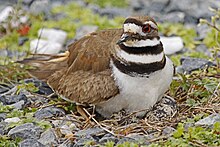Charadrius
| Charadrius | |
|---|---|

| |
| Killdeer(Charadrius vociferus) | |
| Scientific classification | |
| Domain: | Eukaryota |
| Kingdom: | Animalia |
| Phylum: | Chordata |
| Class: | Aves |
| Order: | Charadriiformes |
| Family: | Charadriidae |
| Subfamily: | Charadriinae |
| Genus: | Charadrius Linnaeus,1758 |
| Type species | |
| Charadrius hiaticula(common ringed plover) Linnaeus, 1758
| |
| Species | |
|
See text | |
| Synonyms | |
Charadriusis a genus ofplovers,a group ofwadingbirds.The genus nameCharadriusis aLate Latinword for a yellowish bird mentioned in the fourth-centuryVulgate. They are found throughout the world.
ManyCharadriusspecies are characterised by breast bands or collars. These can be (in the adult) single complete bands (ringed, semipalmated, little ringed, long-billed),or double or triple bands (killdeer, three-banded, Forbes').
They have relatively short bills and feed mainly on insects, worms or other invertebrates, depending on habitat, which are obtained by a run-and-pause technique, rather than the steady probing of some other wader groups. They hunt by sight, rather than by feel as do longer-billed waders likesnipe.
Species of the generaAegialites(orAegialitis),Thinornis,andElseyornisare now subsumed withinCharadrius.The former genus nameThinorniscombined theAncient Greekthismeaning "beach" or "sand" withornismeaning "bird".[1]
Taxonomy
[edit]ThegenusCharadriuswas introduced in 1758 by the Swedish naturalistCarl Linnaeusin thetenth editionof hisSystema Naturae.[2]The name had been used (asCharadrios sive Hiaticula) by the Italian naturalistUlisse Aldrovandiin 1603 for thecommon ringed plover.[3]The word isLate Latinand is mentioned in theVulgate Bible.It derives from theAncient Greekχαραδριος/kharadrios,an unidentified plain-coloured nocturnal bird that was found in ravines and river valleys (fromkharadra,"ravine" ).[a][5]Thetype speciesis the common ringed plover.[6]However, it once appeared that the taxonomy of “Charadrius”was erroneous, as for example theKentish ploveris more closely related to lapwings than it is to, say, the greater ringed plover. Hence, either all members of Charadriidae, excludingPluvialisare grouped in a single genus,Charadrius,or the genus is reduced to theCommon ringed plover,Piping plover,Semipalmated plover,andKilldeer.[7]The latter option was chosen.
Species
[edit]The genus originally contained 33 species. However, in December 2023, TheInternational Ornithologists' Unionincorporated all species underThinornisandElseyornisintoCharadrius,and some species ofCharadriusare now placed in the genusAnarhynchus.As a result,Charadriusnow consists of only 11 species:[8]
- KilldeerCharadrius vociferusLinnaeus, 1758
- Common ringed ploverCharadrius hiaticulaLinnaeus, 1758
- Semipalmated ploverCharadrius semipalmatusBonaparte, 1825
- Piping ploverCharadrius melodusOrd, 1824
- Hooded ploverCharadrius cucullatusVieillot, 1818
- Forbes's ploverCharadrius forbesi(Shelley, 1883)
- Three-banded ploverCharadrius tricollarisVieillot, 1818
- Black-fronted dotterelCharadrius melanopsVieillot, 1818
- Shore ploverCharadrius novaeseelandiaeGmelin, JF, 1789
- Little ringed ploverCharadrius dubiusScopoli, 1786
- Long-billed ploverCharadrius placidusGray, JE & Gray, GR, 1863
Another species, theAuckland Islands shore plover(Charadrius(Thinornis)rossii), known from just one specimen collected in 1840, is now generally considered to be a juvenile shore plover whose location was incorrectly recorded.[9]
Gallery
[edit]-
Black-fronted Dotterel(C. melanops)
-
Semipalmated plover(C. semipalmatus)
-
Three-banded plover(C. tricollaris) eggs on open ground
-
Little ringed plover(C. dubius) chick
Notes
[edit]References
[edit]- ^Jobling, James A. (2010).The Helm Dictionary of Scientific Bird Names.London: Christopher Helm. p. 384.ISBN978-1-4081-2501-4.
- ^Linnaeus, Carl(1758).Systema Naturae per regna tria naturae, secundum classes, ordines, genera, species, cum characteribus, differentiis, synonymis, locis(in Latin). Vol. 1 (10th ed.). Holmiae (Stockholm): Laurentii Salvii. p. 150.
- ^Aldrovandi, Ulisse(1599).Vlyssis Aldrovandi philosophi ac medici Bononiensis historiam naturalem in gymnasio Bononiensi profitentis, Ornithologiae(in Latin). Vol. 1. Bononiae (Bologna, Italy): Franciscum de Franciscis Senensem. pp. 536–537, Lib. 20 Cap. 67.
- ^Anonymous (1592).Biblia sacra vulgatae editionis(in Latin). Rome: Ex. Typographica Apostolica Vaticana. p. 92, Leviticus Chapter 11 Verse 19.
- ^Jobling, James A. (2010).The Helm Dictionary of Scientific Bird Names.London: Christopher Helm. p. 99.ISBN978-1-4081-2501-4.
- ^Peters, James Lee,ed. (1934).Check-List of Birds of the World.Vol. 2. Cambridge, Massachusetts: Harvard University Press. p. 245.
- ^Černý, David; Natale, Rossy (24 September 2023)."Comprehensive taxon sampling and vetted fossils help clarify the time tree of shorebirds (Aves, Charadriiformes)".bioRxiv.doi:10.1101/2021.07.15.452585.
- ^International Ornithologists' Union.Gill, Frank;Donsker, David;Rasmussen, Pamela(eds.)."IOC World Bird List 14.1"(xlsx).Retrieved2023-12-20.
- ^Gill, Brian J.; Bell, B. D.; Chambers, G. K.; Medway, D. G.; Palma, R. L.; Scofield, R. P.; Tennyson, A. J. D.; Worthy, T. H. (2010).Checklist of the Birds of New Zealand(4th ed.). Wellington, N.Z.: Te Papa Press.ISBN978-1-877385-59-9.
Further reading
[edit]- Les Christidis, Walter Boles:Systematics and Taxonomy of Australian Birds.CSIRO Publishing. 2008.ISBN978-0-643-06511-6







